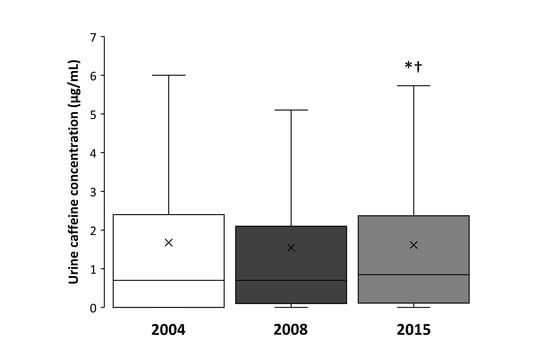Urine Caffeine Concentration in Doping Control Samples from 2004 to 2015
Abstract
1. Introduction
2. Materials and Methods
2.1. Urine Analysis
2.2. Validation Procedure
2.3. Statistical Analysis
3. Results
4. Discussion
5. Conclusions
Author Contributions
Funding
Acknowledgments
Conflicts of Interest
References
- Souza, D.B.; Del Coso, J.; Casonatto, J.; Polito, M.D. Acute effects of caffeine-containing energy drinks on physical performance: A systematic review and meta-analysis. Eur. J. Nutr. 2017, 56, 13–27. [Google Scholar] [CrossRef] [PubMed]
- Southward, K.; Rutherfurd-Markwick, K.J.; Ali, A. The effect of acute caffeine ingestion on endurance performance: A systematic review and meta-analysis. Sports Med. 2018, 48, 1913–1928. [Google Scholar] [CrossRef] [PubMed]
- Grgic, J. Caffeine ingestion enhances wingate performance: A meta-analysis. Eur. J. Sport Sci. 2018, 18, 219–225. [Google Scholar] [CrossRef] [PubMed]
- Del Coso, J.; Salinero, J.J.; Gonzalez-Millan, C.; Abian-Vicen, J.; Perez-Gonzalez, B. Dose response effects of a caffeine-containing energy drink on muscle performance: A repeated measures design. J. Int. Soc. Sports Nutr. 2012, 9, 21. [Google Scholar] [CrossRef]
- Grgic, J.; Trexler, E.T.; Lazinica, B.; Pedisic, Z. Effects of caffeine intake on muscle strength and power: A systematic review and meta-analysis. J. Inter. Soc. Sports Nutr. 2018, 15, 11. [Google Scholar] [CrossRef]
- Puente, C.; Abian-Vicen, J.; Salinero, J.J.; Lara, B.; Areces, F.; Del Coso, J. Caffeine improves basketball performance in experienced basketball players. Nutrients 2017, 9, 1033. [Google Scholar] [CrossRef]
- Del Coso, J.; Estevez, E.; Mora-Rodriguez, R. Caffeine effects on short-term performance during prolonged exercise in the heat. Med. Sci. Sports Exerc. 2008, 40, 744–751. [Google Scholar] [CrossRef]
- Diaz-Lara, F.J.; Del Coso, J.; Garcia, J.M.; Portillo, L.J.; Areces, F.; Abian-Vicen, J. Caffeine improves muscular performance in elite brazilian jiu-jitsu athletes. Eur. J. Sport Sci. 2016, 16, 1079–1086. [Google Scholar] [CrossRef]
- Maughan, R.J.; Burke, L.M.; Dvorak, J.; Larson-Meyer, D.E.; Peeling, P.; Phillips, S.M.; Rawson, E.S.; Walsh, N.P.; Garthe, I.; Geyer, H. IOC consensus statement: Dietary supplements and the high-performance athlete. Int. J. Sport Nutr. Exerc. Metab. 2018, 28, 104–125. [Google Scholar] [CrossRef]
- Pickering, C.; Kiely, J. Are the current guidelines on caffeine use in sport optimal for everyone? Inter-individual variation in caffeine ergogenicity, and a move towards personalised sports nutrition. Sports Med. 2018, 48, 7–16. [Google Scholar] [CrossRef] [PubMed]
- Womack, C.J.; Saunders, M.J.; Bechtel, M.K.; Bolton, D.J.; Martin, M.; Luden, N.D.; Dunham, W.; Hancock, M. The influence of a CYP1A2 polymorphism on the ergogenic effects of caffeine. J. Int. Soc. Sports Nutr. 2012, 9, 7. [Google Scholar] [CrossRef] [PubMed]
- Rahimi, R. The effect of CYP1A2 genotype on the ergogenic properties of caffeine during resistance exercise: A randomized, double-blind, placebo-controlled, crossover study. Ir. J. Med. Sci. 2018. [Google Scholar] [CrossRef]
- Guest, N.; Corey, P.; Vescovi, J.; El-Sohemy, A. Caffeine, CYP1A2 genotype, and endurance performance in athletes. Med. Sci. Sports Exerc. 2018, 50, 1570–1578. [Google Scholar] [CrossRef] [PubMed]
- Pataky, M.W.; Womack, C.J.; Saunders, M.J.; Goffe, J.L.; D’Lugos, A.C.; El-Sohemy, A.; Luden, N.D. Caffeine and 3-km cycling performance: Effects of mouth rinsing, genotype, and time of day. Scand. J. Med. Sci. Sports 2016, 26, 613–619. [Google Scholar] [CrossRef]
- Algrain, H.; Thomas, R.; Carrillo, A.; Ryan, E.; Kim, C.; Lettan, R.; Ryan, E. The effects of a polymorphism in the cytochrome p450 CYP1A2 gene on performance enhancement with caffeine in recreational cyclists. J. Caffeine Res. 2015, 6, 1–6. [Google Scholar] [CrossRef]
- Salinero, J.J.; Lara, B.; Ruiz-Vicente, D.; Areces, F.; Puente-Torres, C.; Gallo-Salazar, C.; Pascual, T.; Del Coso, J. CYP1A2 genotype variations do not modify the benefits and drawbacks of caffeine during exercise: A pilot study. Nutrients 2017, 9, 269. [Google Scholar] [CrossRef]
- Puente, C.; Abian-Vicen, J.; Del Coso, J.; Lara, B.; Salinero, J.J. The CYP1A2-163C>A polymorphism does not alter the effects of caffeine on basketball performance. PLoS ONE 2018, 13, e0195943. [Google Scholar] [CrossRef]
- Bell, D.G.; McLellan, T.M. Exercise endurance 1, 3, and 6 h after caffeine ingestion in caffeine users and nonusers. J. Appl. Physiol. 2002, 93, 1227–1234. [Google Scholar] [CrossRef]
- Beaumont, R.; Cordery, P.; Funnell, M.; Mears, S.; James, L.; Watson, P. Chronic ingestion of a low dose of caffeine induces tolerance to the performance benefits of caffeine. J. Sports Sci. 2017, 35, 1920–1927. [Google Scholar] [CrossRef]
- Dodd, S.L.; Brooks, E.; Powers, S.K.; Tulley, R. The effects of caffeine on graded exercise performance in caffeine naive versus habituated subjects. Eur. J. Appl. Physiol. Occup. Physiol. 1991, 62, 424–429. [Google Scholar] [CrossRef]
- Goncalves, L.S.; Painelli, V.S.; Yamaguchi, G.; Oliveira, L.F.; Saunders, B.; da Silva, R.P.; Maciel, E.; Artioli, G.G.; Roschel, H.; Gualano, B. Dispelling the myth that habitual caffeine consumption influences the performance response to acute caffeine supplementation. J. Appl. Physiol. 2017, 123, 213–220. [Google Scholar] [CrossRef]
- Fulton, J.L.; Dinas, P.C.; Carrillo, A.E.; Edsall, J.R.; Ryan, E.J. Impact of genetic variability on physiological responses to caffeine in humans: A systematic review. Nutrients 2018, 10, 1373. [Google Scholar] [CrossRef] [PubMed]
- Salinero, J.J.; Lara, B.; Abian-Vicen, J.; Gonzalez-Millan, C.; Areces, F.; Gallo-Salazar, C.; Ruiz-Vicente, D.; Del Coso, J. The use of energy drinks in sport: Perceived ergogenicity and side effects in male and female athletes. Br. J. Nutr. 2014, 112, 1494–1502. [Google Scholar] [CrossRef]
- Peeling, P.; Binnie, M.J.; Goods, P.S.; Sim, M.; Burke, L.M. Evidence-based supplements for the enhancement of athletic performance. Int. J. Sport Nutr. Exerc. Metab. 2018, 28, 178–187. [Google Scholar] [CrossRef] [PubMed]
- Spriet, L.L. Exercise and sport performance with low doses of caffeine. Sports Med. 2014, 44, 175–184. [Google Scholar] [CrossRef]
- World Anti-Doping Agency. Monitoring program. Available online: https://www.wada-ama.org/en/resources/science-medicine/monitoring-program (accessed on 1 July 2018).
- Van Thuyne, W.; Roels, K.; Delbeke, F. Distribution of caffeine levels in urine in different sports in relation to doping control. Int. J. Sports Med. 2005, 26, 714–718. [Google Scholar] [CrossRef] [PubMed]
- Van Thuyne, W.; Delbeke, F. Distribution of caffeine levels in urine in different sports in relation to doping control before and after the removal of caffeine from the wada doping list. Int. J. Sports Med. 2006, 27, 745–750. [Google Scholar] [CrossRef]
- Del Coso, J.; Muñoz, G.; Muñoz-Guerra, J. Prevalence of caffeine use in elite athletes following its removal from the world anti-doping agency list of banned substances. Appl. Physiol. Nutr. Metab. 2011, 36, 555–561. [Google Scholar] [CrossRef] [PubMed]
- Lopez-Gonzalez, L.M.; Sanchez-Oliver, A.J.; Mata, F.; Jodra, P.; Antonio, J.; Dominguez, R. Acute caffeine supplementation in combat sports: A systematic review. J. Int. Soc. Sports Nutr. 2018, 15, 60. [Google Scholar] [CrossRef] [PubMed]
- Salinero, J.J.; Lara, B.; Del Coso, J. Effects of acute ingestion of caffeine on team sports performance: A systematic review and meta-analysis. Res. Sports Med. 2018, 1–19. [Google Scholar] [CrossRef] [PubMed]
- World Anti-Doping Agency. Guidelines for Urine Sample Collection. Available online: https://www.wada-ama.org/sites/default/files/resources/files/WADA_Guidelines_Urine_Sample_Collection_v5.1_EN.pdf (accessed on 25 June 2018).
- Del Coso, J.; Munoz-Fernandez, V.E.; Munoz, G.; Fernandez-Elias, V.E.; Ortega, J.F.; Hamouti, N.; Barbero, J.C.; Munoz-Guerra, J. Effects of a caffeine-containing energy drink on simulated soccer performance. PLoS ONE 2012, 7, e31380. [Google Scholar] [CrossRef]
- Del Coso, J.; Portillo, J.; Munoz, G.; Abian-Vicen, J.; Gonzalez-Millan, C.; Munoz-Guerra, J. Caffeine-containing energy drink improves sprint performance during an international rugby sevens competition. Amino Acids 2013, 44, 1511–1519. [Google Scholar] [CrossRef] [PubMed]
- Del Coso, J.; Ramirez, J.A.; Munoz, G.; Portillo, J.; Gonzalez-Millan, C.; Munoz, V.; Barbero-Alvarez, J.C.; Munoz-Guerra, J. Caffeine-containing energy drink improves physical performance of elite rugby players during a simulated match. Appl. Physiol. Nutr. Metab. 2013, 38, 368–374. [Google Scholar] [CrossRef] [PubMed]
- Kovacs, E.M.; Martin, A.M.; Brouns, F. The effect of ad libitum ingestion of a caffeinated carbohydrate-electrolyte solution on urinary caffeine concentration after 4 hours of endurance exercise. Int. J. Sports Med. 2002, 23, 237–241. [Google Scholar] [CrossRef] [PubMed]
- Pasman, W.J.; van Baak, M.A.; Jeukendrup, A.E.; de Haan, A. The effect of different dosages of caffeine on endurance performance time. Int. J. Sports Med. 1995, 16, 225–230. [Google Scholar] [CrossRef] [PubMed]
- Lara, B.; Ruiz-Vicente, D.; Areces, F.; Abian-Vicen, J.; Salinero, J.J.; Gonzalez-Millan, C.; Gallo-Salazar, C.; Del Coso, J. Acute consumption of a caffeinated energy drink enhances aspects of performance in sprint swimmers. Br. J. Nutr. 2015, 114, 908–914. [Google Scholar] [CrossRef]
- Perez-Lopez, A.; Salinero, J.J.; Abian-Vicen, J.; Valades, D.; Lara, B.; Hernandez, C.; Areces, F.; Gonzalez, C.; Del Coso, J. Caffeinated energy drinks improve volleyball performance in elite female players. Med. Sci. Sports Exerc. 2015, 47, 850–856. [Google Scholar] [CrossRef]
- Chia, J.S.; Barrett, L.A.; Chow, J.Y.; Burns, S.F. Effects of caffeine supplementation on performance in ball games. Sports Med. 2017, 47, 2453–2471. [Google Scholar] [CrossRef] [PubMed]
- Coswig, V.S.; Gentil, P.; Irigon, F.; Del Vecchio, F.B. Caffeine ingestion changes time-motion and technical-tactical aspects in simulated boxing matches: A randomized double-blind pla-controlled crossover study. Eur.J. Sport Sci. 2018, 18, 975–983. [Google Scholar] [CrossRef] [PubMed]
- Gallo-Salazar, C.; Areces, F.; Abian-Vicen, J.; Lara, B.; Salinero, J.J.; Gonzalez-Millan, C.; Portillo, J.; Munoz, V.; Juarez, D.; Del Coso, J. Enhancing physical performance in elite junior tennis players with a caffeinated energy drink. Int. J. Sports Physiol. Perform. 2015, 10, 305–310. [Google Scholar] [CrossRef]
- Abian, P.; Del Coso, J.; Salinero, J.J.; Gallo-Salazar, C.; Areces, F.; Ruiz-Vicente, D.; Lara, B.; Soriano, L.; Munoz, V.; Abian-Vicen, J. The ingestion of a caffeinated energy drink improves jump performance and activity patterns in elite badminton players. J. Sports Sci. 2015, 33, 1042–1050. [Google Scholar] [CrossRef]
- McLean, C.; Graham, T.E. Effects of exercise and thermal stress on caffeine pharmacokinetics in men and eumenorrheic women. J. Appl. Physiol. 2002, 93, 1471–1478. [Google Scholar] [CrossRef]
- Magkos, F.; Kavouras, S.A. Caffeine use in sports, pharmacokinetics in man, and cellular mechanisms of action. Crit. Rev. Food Sci. Nutr. 2005, 45, 535–562. [Google Scholar] [CrossRef]
- Burke, L.M. Caffeine and sports performance. Appl. Physiol. Nutr. Metab. 2008, 33, 1319–1334. [Google Scholar] [CrossRef]
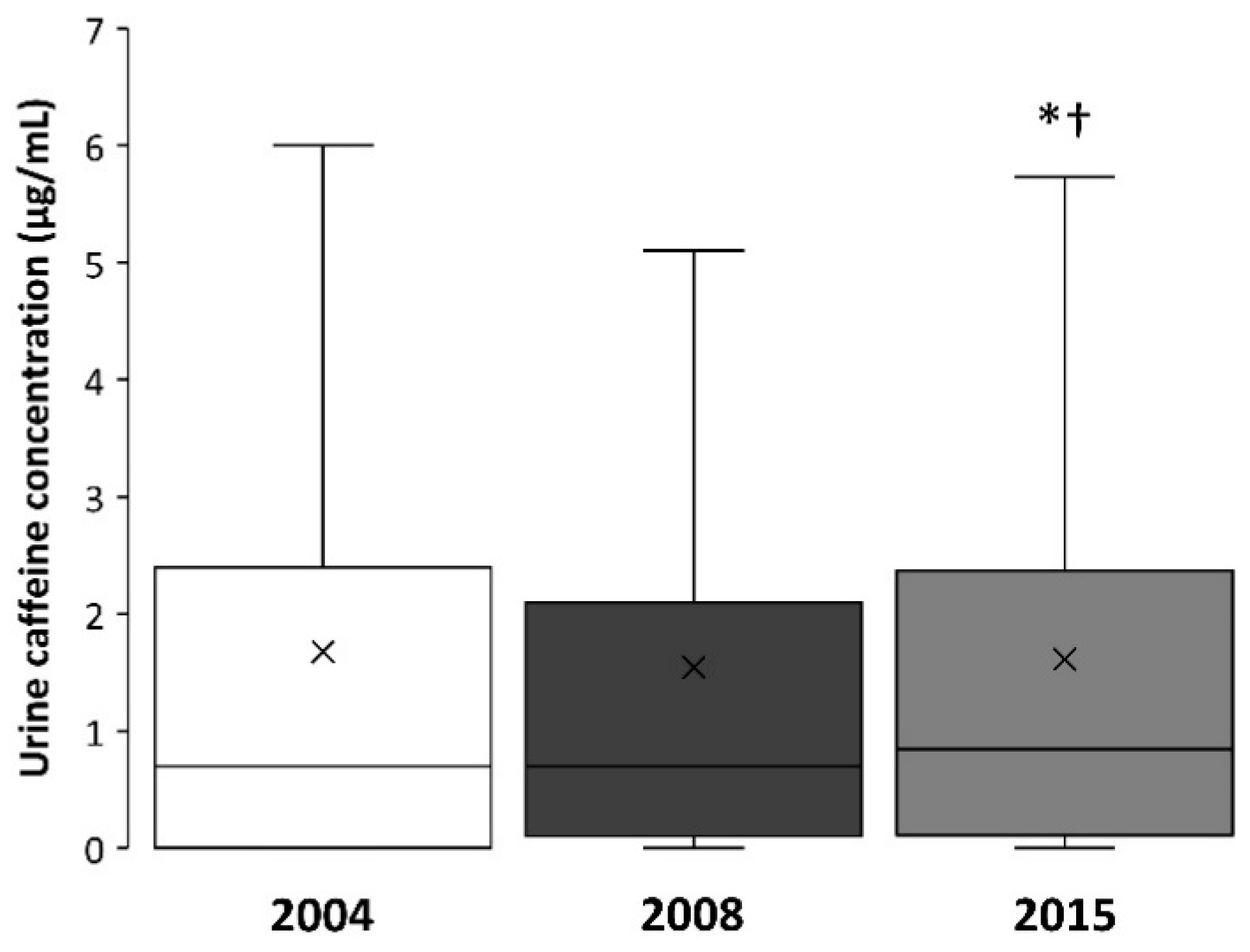
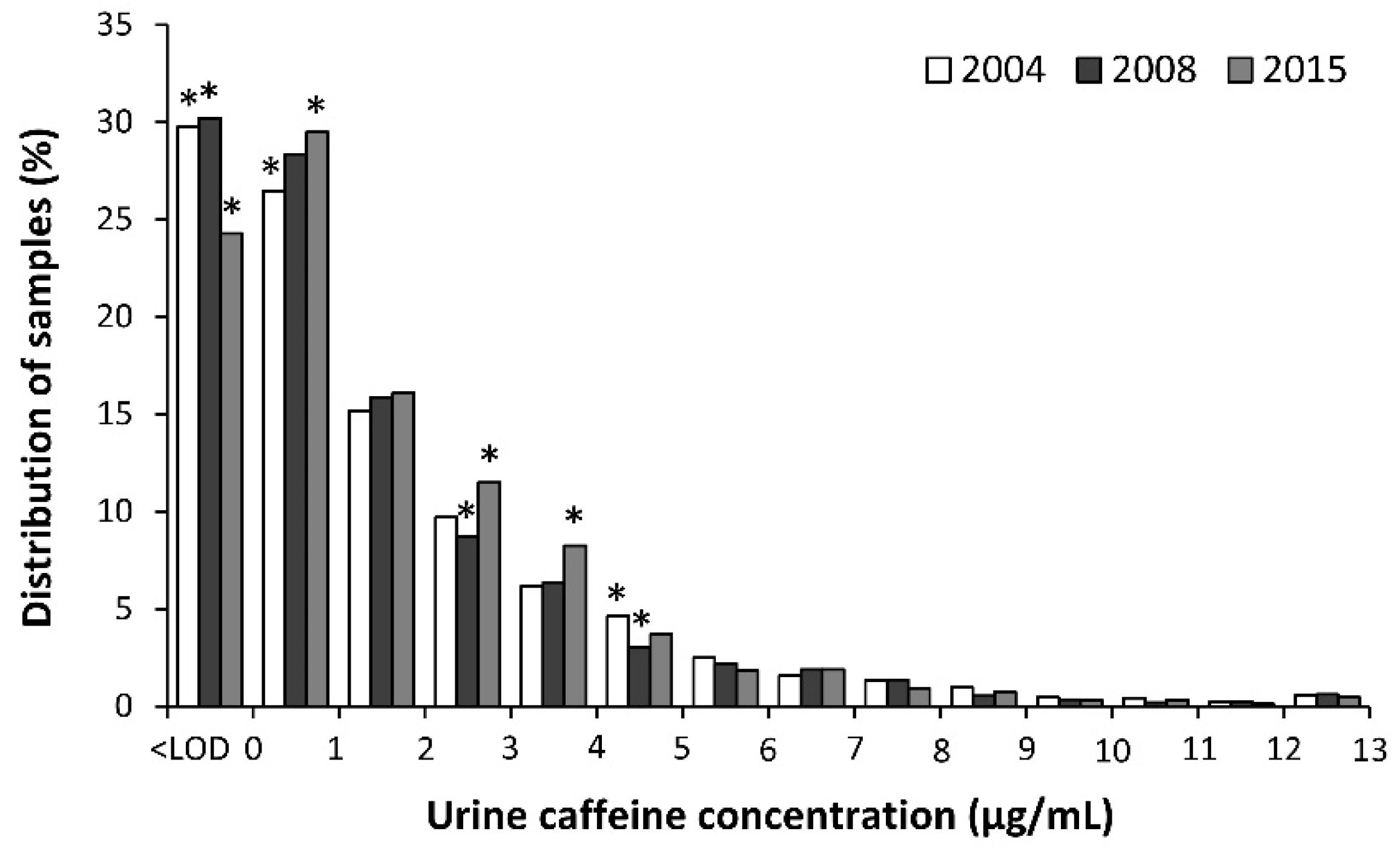
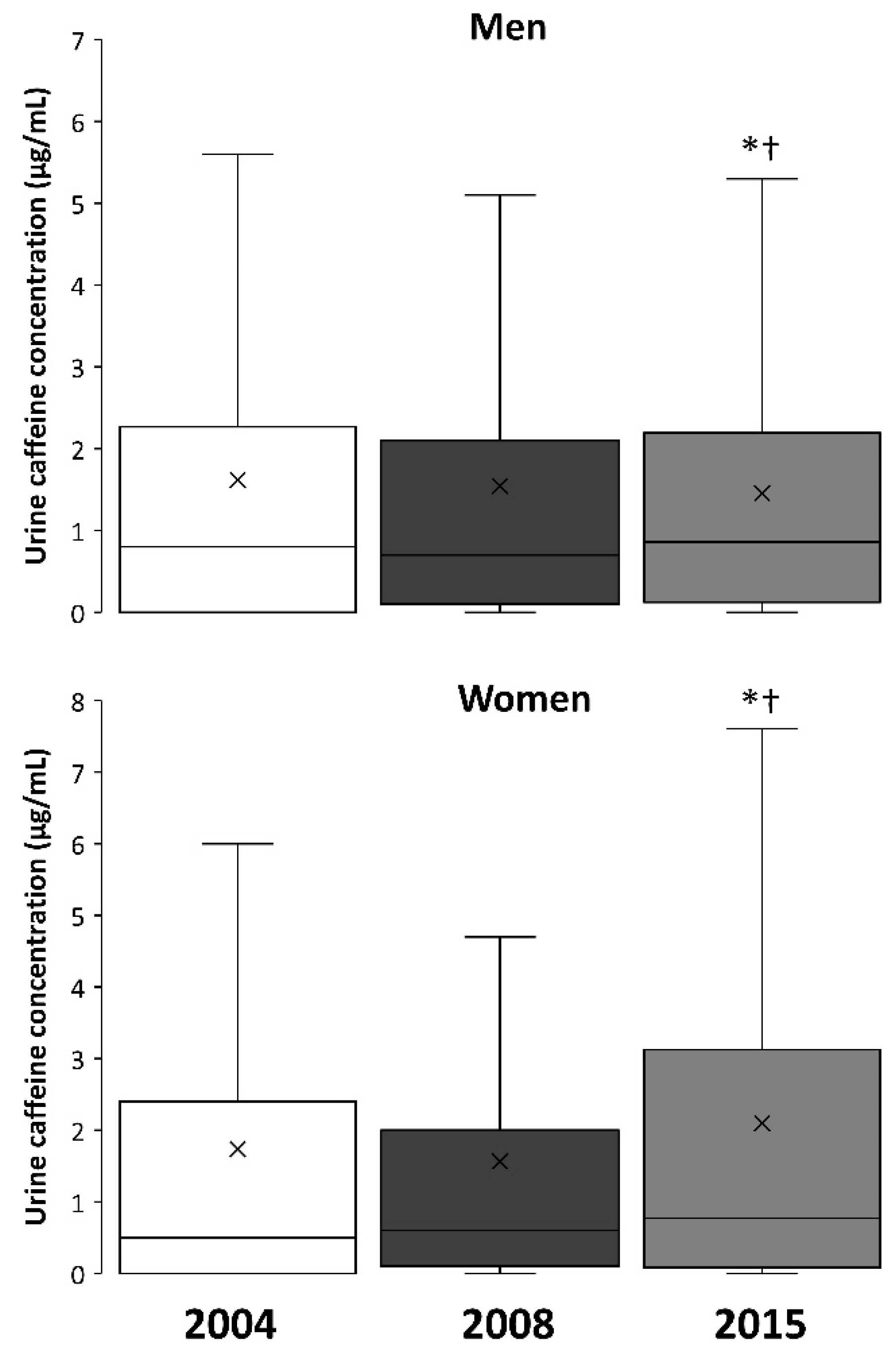
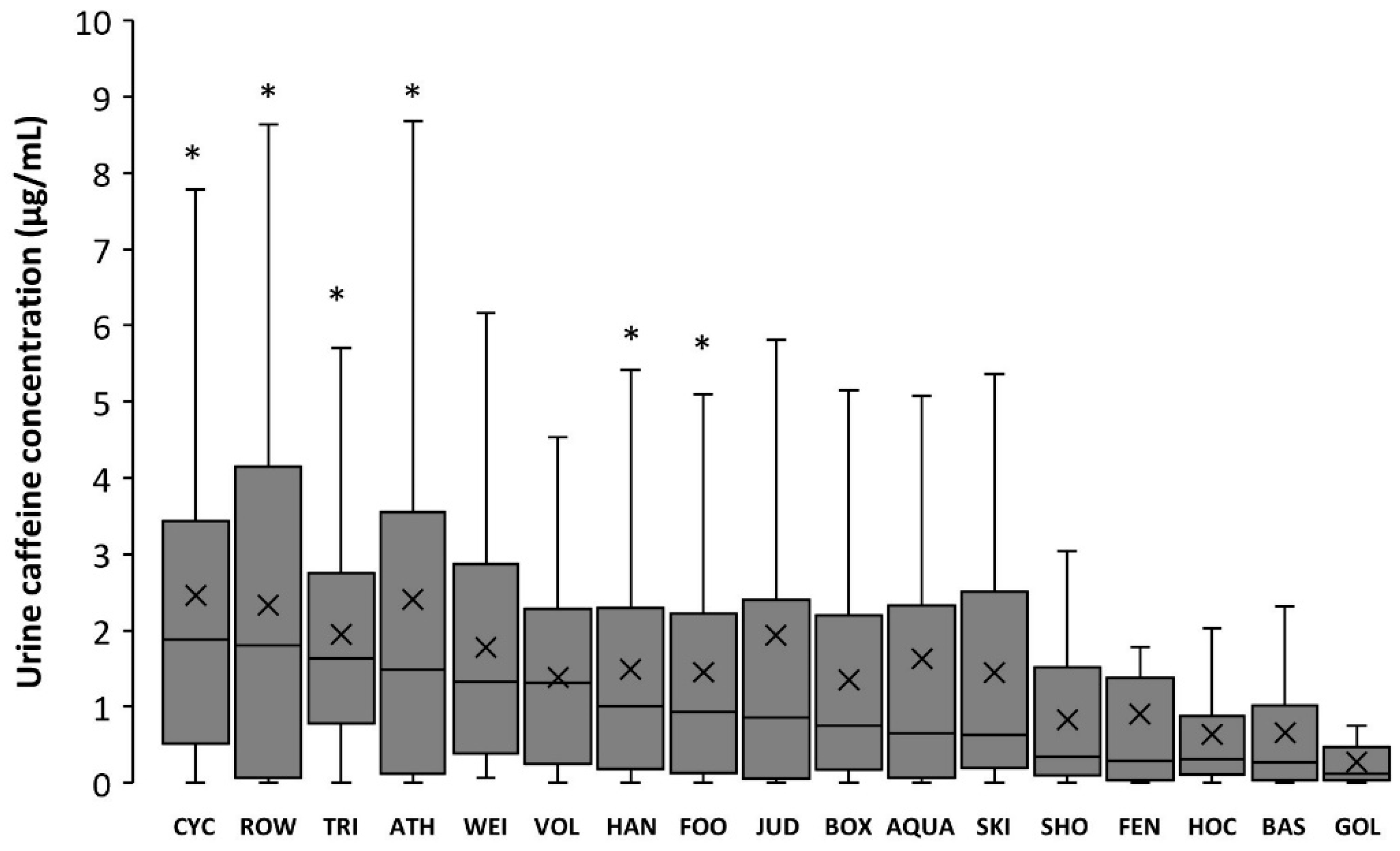
| Sport | 2004 | 2008 | 2015 | p Value |
|---|---|---|---|---|
| Aquatics | 0.1 (0.0–0.8) | 0.1 (0.0–1.2) | 0.7 (0.1–2.3) *† | <0.01 |
| Athletics | 0.7 (0.0–2.6) | 0.8 (0.1–2.4) | 1.5 (0.1–3.6) *† | <0.01 |
| Basketball | 0.2 (0.0–0.9) | 0.4 (0.0–1.2) | 0.3 (0.1–1.0) | 0.13 |
| Boxing | 0.5 (0.0–0.9) | 0.0 (0.0–0.8) | 0.8 (0.2–2.2) *† | <0.01 |
| Cycling | 2.0 (0.5–4.0) | 1.7 (0.5–3.6) | 1.9 (0.5–3.4) | 0.30 |
| Fencing | 0.5 (0.0–0.9) | 0.1 (0.0–0.8) | 0.3 (0.1–1.4) | 0.19 |
| Football | 0.7 (0.0–2.0) | 0.5 (0.1–1.6) | 0.9 (0.1–2.2) *† | <0.01 |
| Golf | 0.0 (0.2–0.4) | 0.0 (0.0–0.0) * | 0.1 (0.0–0.5) † | <0.01 |
| Handball | 1.0 (0.2–2.7) | 0.9 (0.1–2.1) | 1.0 (0.2–2.3) | 0.40 |
| Hockey | 0.4 (0.0–1.6) | 0.9 (0.2–2.2) | 0.3 (0.3–0.9) | 0.60 |
| Judo | 0.2 (0.0–0.8) | 0.2 (0.0–0.5) | 0.9 (0.1–2.4) *† | <0.01 |
| Rowing | 0.4 (0.1–1.6) | 2.7 (0.1–5.0) * | 1.8 (0.1–4.1) * | <0.01 |
| Shooting | 0.4 (0.0–2.0) | 0.1 (0.0–1.7) | 0.3 (0.1–1.5) | 0.24 |
| Skiing | 0.2 (0.0–1.0) | 0.3 (0.1–0.9) | 0.6 (0.2–2.5) † | 0.03 |
| Triathlon | 1.2 (0.3–4.2) | 3.0 (1.5–6.2) * | 1.6 (0.8–2.8) | <0.01 |
| Volleyball | 0.9 (0.1–2.0) | 1.5 (0.2–2.6) | 1.3 (0.3–2.2) | 0.45 |
| Weightlifting | 0.2 (0.0–1.2) | 0.6 (0.0–1.8) | 1.3 (0.4–2.9) *† | 0.01 |
© 2019 by the authors. Licensee MDPI, Basel, Switzerland. This article is an open access article distributed under the terms and conditions of the Creative Commons Attribution (CC BY) license (http://creativecommons.org/licenses/by/4.0/).
Share and Cite
Aguilar-Navarro, M.; Muñoz, G.; Salinero, J.J.; Muñoz-Guerra, J.; Fernández-Álvarez, M.; Plata, M.d.M.; Del Coso, J. Urine Caffeine Concentration in Doping Control Samples from 2004 to 2015. Nutrients 2019, 11, 286. https://doi.org/10.3390/nu11020286
Aguilar-Navarro M, Muñoz G, Salinero JJ, Muñoz-Guerra J, Fernández-Álvarez M, Plata MdM, Del Coso J. Urine Caffeine Concentration in Doping Control Samples from 2004 to 2015. Nutrients. 2019; 11(2):286. https://doi.org/10.3390/nu11020286
Chicago/Turabian StyleAguilar-Navarro, Millán, Gloria Muñoz, Juan José Salinero, Jesús Muñoz-Guerra, María Fernández-Álvarez, María del Mar Plata, and Juan Del Coso. 2019. "Urine Caffeine Concentration in Doping Control Samples from 2004 to 2015" Nutrients 11, no. 2: 286. https://doi.org/10.3390/nu11020286
APA StyleAguilar-Navarro, M., Muñoz, G., Salinero, J. J., Muñoz-Guerra, J., Fernández-Álvarez, M., Plata, M. d. M., & Del Coso, J. (2019). Urine Caffeine Concentration in Doping Control Samples from 2004 to 2015. Nutrients, 11(2), 286. https://doi.org/10.3390/nu11020286






